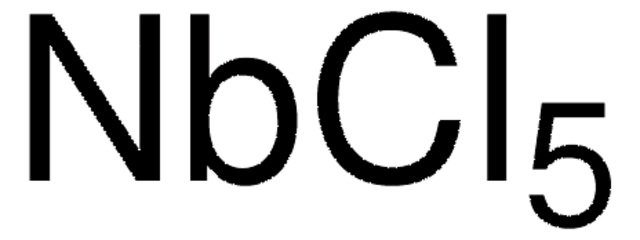208353
Molybdän(V)-chlorid
95%
Synonym(e):
Molybdenum pentachloride, Pentachloromolybdenum
About This Item
Empfohlene Produkte
Dampfdruck
1.75 mmHg ( 25 °C)
131 mmHg ( 250 °C)
Qualitätsniveau
Assay
95%
Form
powder
Eignung der Reaktion
reagent type: catalyst
core: molybdenum
Verunreinigungen
<0.5% insoluble matter
bp
268 °C (lit.)
mp (Schmelzpunkt)
194 °C (lit.)
Dichte
2.928 g/mL at 25 °C (lit.)
Anwendung(en)
battery manufacturing
SMILES String
Cl[Mo](Cl)(Cl)(Cl)Cl
InChI
1S/5ClH.Mo/h5*1H;/q;;;;;+5/p-5
InChIKey
GICWIDZXWJGTCI-UHFFFAOYSA-I
Suchen Sie nach ähnlichen Produkten? Aufrufen Leitfaden zum Produktvergleich
Allgemeine Beschreibung
Anwendung
- Condensation of nitrobenzene with alcohols and C-C coupling of alkenyllithium reagents.
- Direct amidation of benzylic alcohols with sulfonamides and carbamates.
It can also be used as aprecursor to synthesize alumina/molybdenum nanocomposites and methylenemolybdenumreagents for chemoselective carbonyl alkenation.
Signalwort
Danger
H-Sätze
Gefahreneinstufungen
Carc. 2 - Eye Dam. 1 - Skin Corr. 1B
Lagerklassenschlüssel
8A - Combustible corrosive hazardous materials
WGK
WGK 3
Flammpunkt (°F)
Not applicable
Flammpunkt (°C)
Not applicable
Hier finden Sie alle aktuellen Versionen:
Besitzen Sie dieses Produkt bereits?
In der Dokumentenbibliothek finden Sie die Dokumentation zu den Produkten, die Sie kürzlich erworben haben.
Kunden haben sich ebenfalls angesehen
Artikel
In the last two decades, a new method termed solid-state metathesis (SSM) has been developed to synthesize compounds that are often difficult to produce conventionally.
Unser Team von Wissenschaftlern verfügt über Erfahrung in allen Forschungsbereichen einschließlich Life Science, Materialwissenschaften, chemischer Synthese, Chromatographie, Analytik und vielen mehr..
Setzen Sie sich mit dem technischen Dienst in Verbindung.











